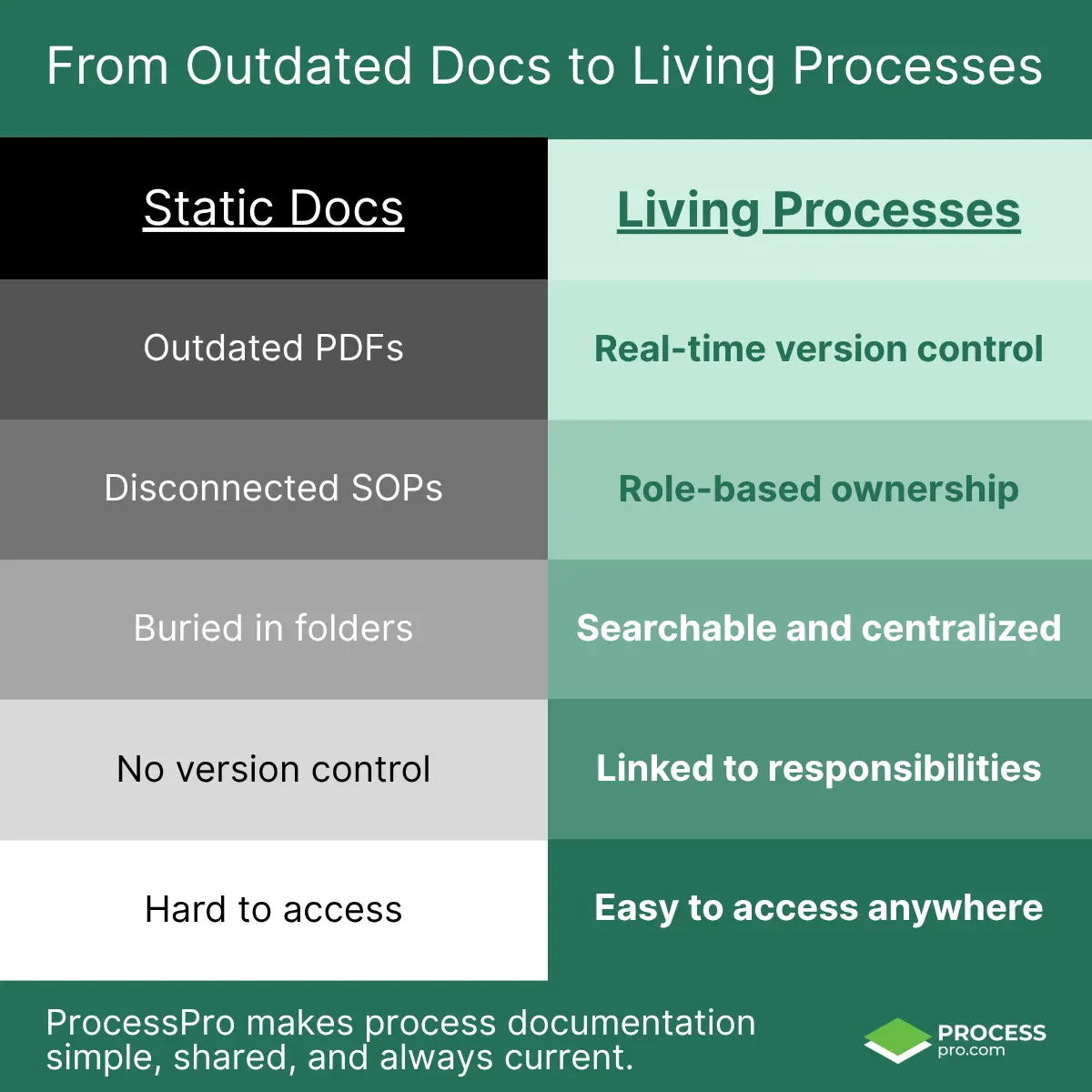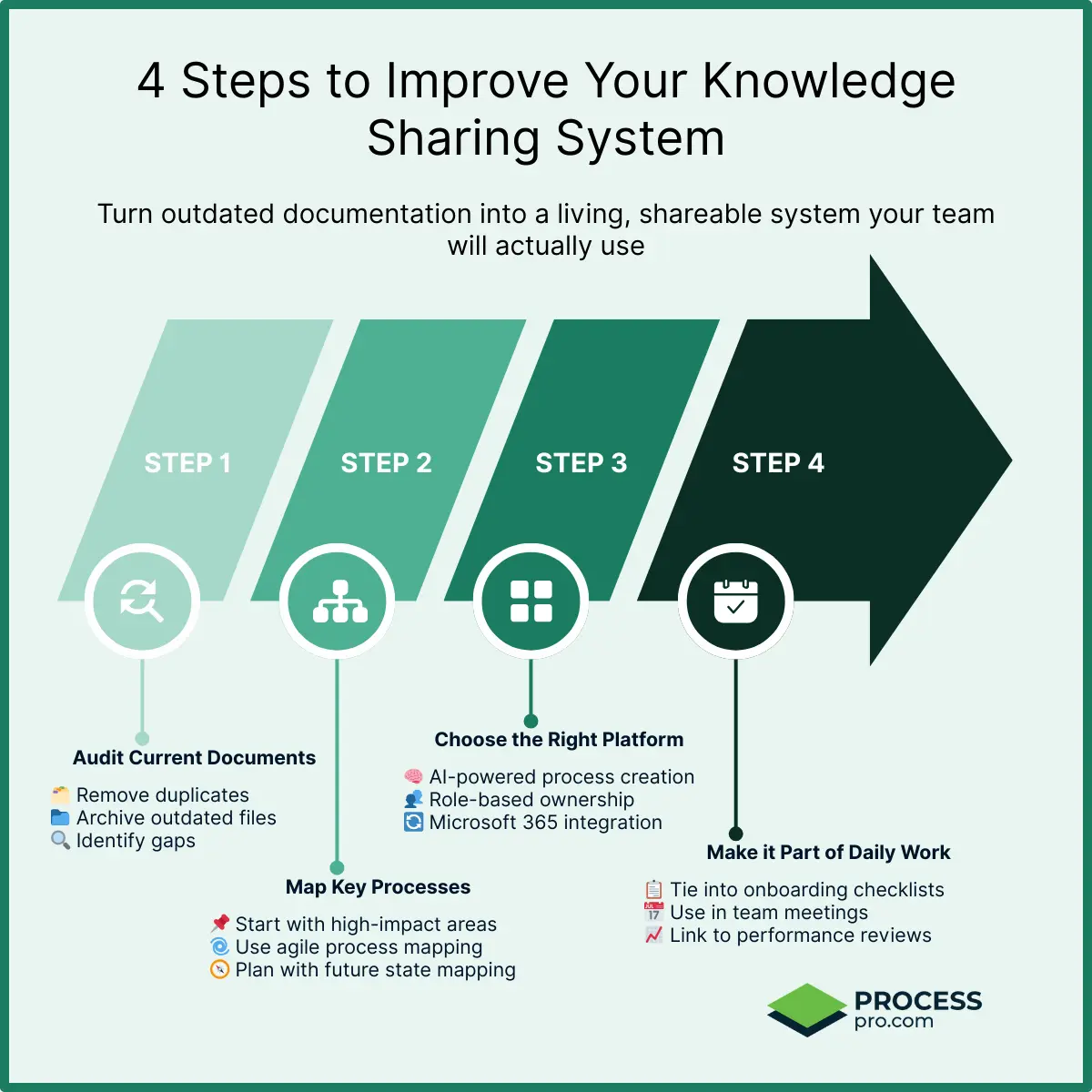Home » Improve knowledge sharing with living processes
Collaboration and Knowledge Management
Improve knowledge sharing with living processes
Knowledge sharing breaks down with outdated SOPs and disconnected files. Living processes keep teams aligned with up-to-date, searchable, and shared documentation.
Knowledge sharing fails when teams use outdated documents. Static SOPs, spreadsheets, and disconnected files slow down your team. They make it hard to find the right information, follow the right steps, or stay consistent across departments.
To fix this, your organization needs living processes. These are simple, searchable, and always current. In this article, we’ll show how switching to living processes improves knowledge sharing, supports your teams, and helps your business grow.
Why static documents hurt knowledge sharing
Static documents create silos, making it harder for teams to access, update, and trust the information they need to do their jobs effectively.
Most companies still rely on tools like Word and Excel to manage their processes. But these tools:
- Go out of date fast
- Don’t show who owns what
- Are buried in folders people can’t find
These issues hurt speed, accuracy, and confidence.
What’s wrong with SOPs and spreadsheets?
When knowledge is hidden or outdated, your team wastes time. They may follow the wrong steps or skip key actions. This leads to:
- Slower onboarding
- More errors and rework
- Missed deadlines or failed audits
A better knowledge management system solves these issues by keeping everything clear, current, and easy to use.
What poor documentation costs your knowledge sharing efforts
What are living processes in knowledge sharing?

Unlike static files, living processes evolve alongside your business, keeping knowledge accurate, accessible, and actionable.
Living processes are stored in one system. They are:
- Easy to update
- Visible to everyone
- Linked to real people and roles
They ensure your team always sees the latest version. There’s no guessing or double-checking.
Using ProcessPro’s visual process maps and dynamic control, you don’t need to be an expert to build clear, useful documentation. Our intuitive editor makes it easy to capture every step of your process and see it in context. Complete visibility lets you spot gaps or process bottlenecks fast, empowering smarter decisions and smoother knowledge sharing.
A smarter way to share process knowledge
When everyone works from the same source, you:
- Reduce mistakes
- Help new hires get up to speed
- Avoid sending emails just to ask where something is
This makes knowledge sharing simple, fast, and part of daily work.
Every team member always sees the most recent version, because version control is built into ProcessPro. That means no more chasing down files or wondering if you’re working from the right SOP. It’s one version, one source of truth, shared across the business.
Why living processes improve organizational knowledge sharing
How collaboration strengthens knowledge sharing
When your team helps build the processes they follow, they trust them more. They also improve them more often.
With collaborative process mapping, teams can:
- Spot missing steps
- Add useful notes
- Share what works in real life
This keeps your processes relevant, and keeps your team engaged.
With feedback tools built into ProcessPro, anyone involved, internal or external, can comment, suggest changes, or flag concerns. Comments are trackable and assignable, so nothing gets lost. It’s a built-in way to promote continuous improvement and reflect real-world experience.
Knowledge sharing for remote and hybrid teams
Remote workers often can’t ask for help in person. If they can’t find what they need, they waste time or make mistakes.
That’s why centralized process access matters. When every team member uses the same tool, they can:
- Find answers on their own
- Avoid delays
- Do their jobs with confidence
Self-service tools also reduce pressure on subject matter experts. Teams can learn, grow, and act without waiting for help.
Because ProcessPro is a cloud-based platform, your team can access process documentation from anywhere, without IT headaches. Whether someone is in the office, working from home, or onboarding in a new location, they get the same up-to-date process knowledge in seconds.
How to improve your knowledge sharing system

To build a system that actually gets used, start by understanding where your current documentation helps, and where it holds you back.
Step 1: Audit your current documents
Start by reviewing what you have:
• Delete duplicates
• Archive outdated files
• Highlight what’s missing or unclear
This gives you a clean slate to improve from.
Step 2: Map key processes to support knowledge sharing
Start with areas that affect many people:
• HR onboarding
• Compliance workflows
• Customer service steps
Use agile process mapping, start small, then improve. You don’t need it perfect on day one.
Want to test improvements before they go live? With ProcessPro’s future state mapping, you can update a process in isolation. Your team keeps using the current version, while you plan and build a better one in the background, ready to publish when you are.
Step 3: Choose the right knowledge sharing platform
Look for a tool that supports:
• Live updates
• Clear ownership
• AI-powered process creation
• Microsoft 365 integration
ProcessPro gives you all this on one platform.
ProcessPro also supports role-based ownership, meaning responsibilities are tied to roles, not individuals. When someone leaves or changes roles, their tasks seamlessly shift to the new person in that role, no manual updates needed. That keeps your processes running smoothly, even as your teams evolve.
Step 4: Make knowledge sharing part of daily work
Your team won’t use what they can’t find. Tie living processes into:
• Onboarding checklists
• Team meetings
• Performance reviews
For example, an HR team can use mapped onboarding processes to assign training, send reminders, and track progress. It’s faster, more helpful, and less work.
What better knowledge sharing unlocks
Teams that use living processes see results fast:
- New hires get up to speed quicker
- Fewer errors and less rework
- Teams communicate better
Good knowledge sharing creates a stronger, smarter organization. Everyone knows what to do, when to do it, and how to do it well.
Want to go a step further? Time and cost analysis in ProcessPro lets you see exactly where effort, resources, and money are being spent across your processes. Compare versions, evaluate resource use, and find savings without sacrificing quality.
Business agility depends on strong knowledge sharing
In unpredictable environments, flexibility is essential. Living processes help teams adapt by giving them a clear structure that evolves.
By updating key steps, collecting feedback, and refining over time, teams stay productive, no matter what changes around them. That’s real agility in action.
Bring your processes to life with ProcessPro
ProcessPro helps you replace outdated documents with smart, connected process tools. You get:
- Role-based ownership
- Real-time updates
- AI-powered creation tools
- Easy integration with Microsoft apps
Your team deserves tools that work like they do, fast, clear, and always up to date.

James Ross
Founder & CEO. James is passionate about all thing Process Mapping and sharing his wealth of experience with his valued clients. He works closely with his teams to ensure that ProcessPro solves real everyday process mapping problems.
Share this article
